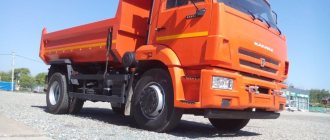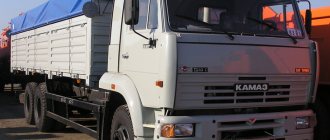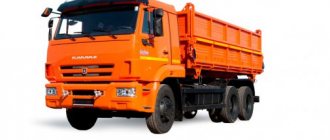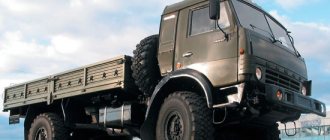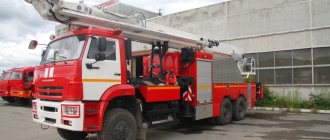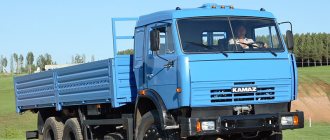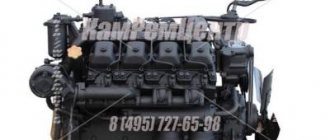About the areas of application of the machine
Relatively low price for a powerful all-wheel drive truck, low diesel fuel consumption, lightness, good cross-country ability and exceptional stability are the obvious advantages of trucks built on the KamAZ-43502 chassis. And at the same time – the secrets of their popularity in Russia and the CIS. This model is used both to staff the vehicle fleet of the Russian armed forces and in the civilian sector. In particular, shift buses of domestic oil and gas producing companies are often installed on the KamAZ-43502 chassis. These are SPTS - specialized cross-country passenger vehicles.
The ambulance, equipped on a KamAZ-43502 chassis and designed to operate in extremely difficult climatic and road conditions, was successfully tested on the Kolyma highway in the winter of 2022, covering 1,370 km from Magadan to a number of settlements and back. In extreme conditions, the driving performance of the car, the performance of autonomous heating and lighting systems, including at night, and the durability of the body and electrical equipment in difficult climatic conditions were tested.
The modern fire truck is built on a KamAZ-43502 all-wheel drive chassis. Its arsenal includes a tank for 3 thousand liters of water, a tank for 200 liters of foam, a pump with a capacity of up to 40 liters per second, a powerful compressor for supplying compressed air, an advanced fire extinguishing and smoke absorption system with Hiromax water mist, and space for a fire crew of seven people. Also, at the Army-2015 and Interpolitech-2015 exhibitions, the Patrol armored vehicle on the KamAZ-43502 chassis was presented.
Fuel consumption standards for KAMAZ vehicles | TRUCK.BIZ
The level of fuel consumption is a very important technical characteristic of a car. In addition to the actual purchase of special equipment, you will need to incur certain expenses for its maintenance, as well as estimate how much each trip will cost. The fuel consumption rate of the KAMAZ vehicle of interest will make it possible to determine the payback of the truck and the feasibility of its use.
Indicators taken into account during calculations
KAMAZ fuel consumption rates are determined by transport companies and other companies that have their own fleet of vehicles. However, the greatest importance is given to dump truck models, since they are produced in different modifications, for each of which the fuel consumption rate will be different.
There are certain general standards. But they do not apply to every situation. There are many factors taken into account when determining fuel consumption rates. These include:
- the season during which the vehicle is planned to be used;
- the service life of the vehicle and its technical condition;
- condition of the internal combustion engine (primarily filters);
- quality of the fuel used.
The fuel consumption rate of KAMAZ trucks per 100 km is determined taking into account the specific model, modification, and area of use. The manufacturer defines some basic unit. However, during the operation of the car, it is expected to take into account other nuances that accompany any transportation of goods.
Since KAMAZ is a truck, it is not used when traveling to work or visiting, since it is too expensive. Such vehicles transport goods. For this reason, the amount of fuel consumed by a vehicle when moving with a loaded body is always taken into account.
The manufacturer determines the basic KAMAZ fuel consumption rate for each individual modification with different load capacity. Thus, special equipment with a load capacity of 7 tons, while driving at a speed of 80 km/h, consumes 30 liters of fuel for every 100 km. A car with a load capacity of 30 tons consumes 8 liters more.
When calculating the fuel consumption rate of KAMAZ dump trucks, it is necessary to take into account the weight of the vehicle without load, as well as its total weight when fully loaded.
Calculation of fuel consumption rates for KAMAZ dump trucks
For vehicles with a loading platform (dump trucks), use the following formula:
Hsanc = Hs + Hw * (Gpr + 0.5 * q)
The meanings of the symbols in this formula:
- Hs is the norm for a 100% loaded vehicle;
- Hw – transport work coefficient;
- Gpr – platform weight;
- q – load capacity of the loading platform.
There is a standard fuel consumption rate for each model, modification and season of work.
When a dump truck is used as a road train, fuel consumption increases to some extent. The number of additional liters is determined by the type of engine:
- for a gasoline engine, the fuel consumption rate increases by 2 liters;
- for diesel - 1.3 l;
- for gas - 2.6 liters.
It should be taken into account that the fuel consumption rate for a road train is higher than for a conventional dump truck.
Fuel consumption rate for tractor and onboard truck
In addition to dump trucks, the Kama Automobile Plant also produces other types of trucks, including flatbed vehicles, as well as truck tractors. Their parameters are calculated using the formula:
Qh = 0.01 * (Hsan * S + Hw * W) * (1 + 0.01 * D)
The symbols of this formula are deciphered as follows:
- Hsan is the norm for completely loaded vehicles.
- Hw is the amount of fuel and lubricants required for transportation.
- W is the amount of work performed by the vehicle.
- D is the error coefficient.
Such cars can also be equipped with different types of engines. For this reason, an additional number of liters must be added to the average quantity, similar to the case with a dump truck.
The values of fuel consumption rates are relative, since their calculation does not imply taking into account the operation of trucks. The road is difficult to predict, and every extreme situation causes an increase in fuel consumption by the car, so the fuel consumption rate in such a situation increases.
About the design and configuration of KamAZ-43502
The all-wheel drive truck is equipped with a classic leaf spring suspension (both front and rear). Along with multi-leaf spring sets, telescopic shock absorbers are also used. KamAZ-43502 is equipped with locking center and wheel differentials, which allows uniform torque to be transmitted to the axles and ensures their stable, rigid connection. Due to this, a heavy vehicle can overcome problem areas on roads and off-roads with relative ease. The wheel differential promotes uniform rotation of the wheels on the axle.
The wheels are disc, have a rim size of 10.00-20 or 12.2-20.9; Tire size – 390/95 R20 or 425/85 R21. Tire type: single-pitch. Pneumatic tires with pressure regulation. All wheels of the car are equipped with drum-type brakes with two internal pads. The main brake assembly is located on a caliper, which is attached to the axle flange. The brake system has a split pneumatic drive. The thickness (width) of the brake linings is 140 mm, the radius of the drums is 200 mm. The diameter of each brake drum is 400 mm. The electrical equipment of the machine includes two 12V / 190 Ah batteries; generator 28V / 3000 W. On-board power supply voltage is 24 V.
The standard equipment of the KamAZ-43502 included two steel fuel tanks with a volume of 210 liters each. This supply of diesel fuel is enough for long journeys even on off-road and dirt roads, not to mention highways with asphalt and concrete pavement. From the factory, you can equip the KamAZ-43502 chassis with a steel flatbed platform with folding side and rear sides. Its internal dimensions are: 4.892 m (length) x 2.470 m (width) x 0.73 m (height). As additional equipment, the KamAZ-43502 truck chassis is equipped with a frame and an awning; It is equipped with a hook-and-loop towing device, as well as a winch.
KamAZ-6460: How to calculate engine hours
Linguists have not come to a consensus, and, despite the fact that the continuous spelling is considered outdated, according to the Dictionary of Abbreviations of the Russian Language, as well as the Spelling Dictionary, motochas is correct to write. Converting engine hours into kilometers is necessary in order to determine the amount of fuel required to refuel agricultural equipment.
| Brand KAMAZ | Fuel consumption Kamaz (summer), liter/100 km | Fuel consumption Kamaz (winter), liter/100 km |
| KAMAZ-6520 | 29.2 l | 32.1 l |
Modifications of KamAZ-43502
KamAZ-43502-3032-14 (S4) – a vehicle with a Cummins ISB 6.7 275 (Euro-4) engine, Bosch injection pump, with a 9-speed ZF9 transmission, a cab with a sleeper;
KamAZ 43502-3026-45 – modification with a KamAZ 740.652-260 engine (Euro-4), a 5-speed KamAZ-154 transmission, a cab without a berth;
KamAZ-43502-3033-45 - a chassis version with a KamAZ 740.652-260 power unit (Euro-4), with a Common Rail electronic fuel injection system, with a 6-speed ZF6 transmission, a cab without a berth;
KamAZ-43502-3036-45 – modification with a KamAZ 740.652-260 engine (Euro-4), with a Common Rail electronic fuel injection system, with a 6-speed ZF6 transmission, a cab with a sleeper;
KamAZ-43502-3038-45 - a truck chassis with a KamAZ 740.652-260 engine (Euro-4), with a Common Rail electronic fuel injection system, with a 6-speed ZF6 transmission, a cab without a berth, with a winch.
In the modern price list of the Kama Automobile Plant, only one modification of the KamAZ-43502 car is offered for sale:
KamAZ-43502-66 (D5) – equipped with a Cummins ISBe6.7 E5 285 (Euro-5) engine and a 9-speed ZF 9S1310 gearbox, as well as a universal cargo chassis with a sleeper cab.
Advantages and disadvantages
Advantages:
- Operating temperature. The equipment functions properly at temperatures of -45…+45°C.
- The reliable and maneuverable chassis makes it possible to operate the equipment in off-road conditions.
- Economical consumption of fuel and oil fluid.
- Availability of a sleeping place. This allows the driver to endure long trips more comfortably.
- All main components and assemblies are located under the hood, which simplifies access to them during repairs and maintenance work.
- Powerful engine, made according to the Euro-4 environmental standard.
- A heating system is installed inside the driver's cabin for operation in the cold season.
- Ease of operation and reliable design.
The disadvantages include:
- high cost compared to similar models;
- fastening nuts, hub and cone ridges wear out quickly;
- Brake chambers do not tolerate low temperatures well.
Some technical specifications in numbers
- The vehicle's carrying capacity is 4.37 tons.
- Total weight – 12.7 tons.
- The load on the rear axle is 7.4 tons, on the front axle - 5.3 tons.
- The maximum weight of the superstructure with cargo is 5.3 tons.
- The total weight of the trailer is 7 tons.
- The total weight of the road train is 19.7 tons.
- The curb weight of the car is 8.625 tons.
- The load on the rear axle is 3.75 tons.
- The load on the front axle is 4.875 tons.
- Overall dimensions of the base chassis: length – 7.57 m; width – 2.55 m; height – 3.08 m.
- Wheelbase – 4,180 m.
- Wheel track width – 2.05 m.
- Front overhang – 1.36 m. Rear overhang – 2.58 m.
- Ground clearance – 0.385 m.
- Turning radius – 11 m.
- The angle of the climb to be overcome is at least 31%.
Calculation of write-off of fuel and lubricants for a loaded truck
I’ve been reading the method of specifying fuel and lubricants standards for the third time - and I still don’t get it.
Conditions: Kamaz drove 50 km with a load of 2.5 tons, back drove 50 km with a load of 1.2 tons. Let’s say the basic norm for Kamaz is 30 l|100 tkm, refilled with diesel fuel, i.e. coefficient 1.3
0.01*(30l*50km + 1.3*2.5t) + 0.01 (30l*50km + 1.3*1.2) = TOTAL
For a truck, an additional norm (diesel -1.3 l/100 ton-km, gasoline 2.0/100 ton-km) is added for transport work ( freight turnover
): there 50 km * 2.5 t = 125 tkm back 50 km * 1.2 t = 60 tkm Fuel consumption will be there (30 l * 50 km + 1.3 l * 125 tkm)/100 back (30 l * 50 km + 1.3 l * 60 tkm)/100
Tatyana, thank you very much Dana7309 (94062)
Tell me how to correctly establish the norms for writing off fuel and lubricants in the accounting policy? Is it possible to determine based on actual fuel consumption based on waybills or not? How to correctly reflect the receipt of diesel fuel if the driver did not provide receipts, but reflected the receipt of fuel in the waybills?
There is no mandatory requirement in the Tax Code of the Russian Federation that the write-off of fuel and lubricants must be carried out according to the standards of the Ministry of Transport. So you can set your own standards. But according to Article 252 of the Tax Code of the Russian Federation, expenses must be economically justified. So you need to justify your norms. For example, draw up fuel consumption measurement reports.
On the second question. You can write anything you want on your waybills. A supporting document is required. Therefore, ask for a receipt from the driver.
Tata//Star (2582b) Tell me how to calculate the consumption of GM for a sewage disposal machine? Rastsislau (56f80)
Tatiana, Hello. Help me please. It is necessary to find out the actual fuel consumption. There is no basic norm! There is 300 liters of fuel consumed. Mileage 500 km with load and 500 km without load. Transported cargo is 100 tons. Coefficient 0.3 per ton. Help me please.
Rastsislau It is necessary to find out the actual fuel consumption.
Rastsislau There is 300 l of fuel consumed
.
Looks like the answer is in the question.
Vladimir, everything is clear, I meant l/100. The company claims that there are no fuel consumption standards and is written off according to the fact. But for some reason they keep you for excessive fuel consumption. I ask why they withheld it - for overspending. Tell me what the norm is - there is no norm. Ksk think, I just can’t understand. That's why I'm asking. Corrections: 1; the last one was at 09/18/2017, 17:34.
Marchenko N. (1c741)
Good afternoon We are engaged in cargo transportation on KAMAZ 65116, with trailers (trailer weight 9 tons). The vehicle travels with a load of 115 km, the weight of the transported cargo is about 23 tons, we work in ton-kilometers. How to calculate fuel consumption per lap, provided that the car is returned with a trailer, but without cargo
Engines KamAZ-43502
Cummins 6.7 series diesel engines are products of the Cummins-Kama joint venture. These are modern in-line six-cylinder diesel engines, equipped with a turbocharging system, with intermediate air cooling, and a Common Rail electronic injection control system. Cylinder diameter – 107 mm; piston stroke – 124 mm. Compression ratio – 17.3:1. Dry engine weight – 512 kg.
The Cummins ISB 6.7 275 modification, which was used on the previously produced KamAZ-43502-3032-14 (S4), has a power of 205 kW (275 hp) at 2500 rpm, and develops a maximum torque of 990 N.m, at 1500 rpm, complies with the Euro-4 environmental class, thanks to the use of the SCR system.
Cummins ISBe6.7 E5 285.
The Cummins ISBe6.7 E5 285 variant is installed on the most modern modification of KamAZ 43502-66 (D5). This turbocharged engine has a power of 285 horsepower and a maximum torque of 1007 N.m (103 kgf.m). The engine complies with Euro-5 environmental class standards.
Eight-cylinder V-shaped diesel engines KamAZ 740.652-260 have the following technical characteristics:
- Working volume – 11.76 liters
- Rated power – 260 horsepower.
- Maximum torque – 1128 N.m., at 1300 rpm.
- Cylinder diameter – 120 mm; piston stroke – 130 mm.
- The compression ratio is 17.9:1.
- Dry engine weight – 870 kg.
KamAZ 740.652-260.
Transmission options
The following types of transmissions were used on KamAZ-43502:
KamAZ-154 is a ten-speed (5x2) manual transmission with a two-stage divider (multiplier) and synchronizers. It consists of a main five-speed gearbox and a two-stage divider, which is located in front of the main manual transmission. The main difference from the KamAZ model 152 gearbox is the tapered bearings in the supports of the primary, intermediate and secondary shafts of the gearbox. Gear ratios: 7.82 – 1.00.
ZF 6S 1000 is a six-speed manual transmission used on the lightest trucks of the Kama Automobile Plant. It is a six-speed gearbox. All forward gears in the main gearbox are activated by synchronizers, and the reverse gear is engaged by a gear clutch. The highest gear is overdrive. Gear ratios: 6.75 – 0.78.
Manual transmission KamAZ-154.
ZF 9S 1310 is a nine-speed manual transmission, which includes a main four-speed gearbox and a planetary range located behind the main box, and has an additional low gear. Its gear ratios range from 9.48 to 0.75, which, with an input torque of 1300 Nm, provides a real reduction in diesel fuel consumption.
The clutch is single-disc, diaphragm, pull-type; previously – models YaMZ-184 or model 19, now – models MFZ 430, from ZF&Sachs. Drive – hydraulic, with pneumatic amplifier. The final drive ratio is 5.94. The transfer case is model 65111, with gear ratios of 0.917 (second gear (high) and 1.662 (first gear (low).
Fuel consumption per 100 km KamAZ: 4308, 4310, 43118, 5320, 65115, 6520, 43253, 65117
The Kama Automobile Plant, better known as KamAZ, is the largest domestic truck manufacturer. The main production of the brand is located in the Republic of Tatarstan, the city of Naberezhnye Chelny.
The history of the brand began in the 60s, when the country suddenly needed to expand its fleet of heavy-duty trucks capable of increasing the productivity of cargo transportation. However, at that time, none of the operating automobile enterprises was able to satisfy the increased demand for heavy-duty vehicles with a carrying capacity of eight to twenty tons.
In the summer of 1969, the country's Council of Ministers approved a package of documents that approved the start of construction of a new complex of automobile plants. According to the documents, the newly formed enterprise will specialize exclusively in the production of heavy trucks.
Currently, KamAZ OJSC is confidently among the top ten global companies in terms of truck production volume. The vehicles of this enterprise occupy one third of the Russian heavy-duty market.
And the total number of countries where the company’s models are operated has exceeded eight dozen.
KamAZ is respected not only for its reliability and maneuverability, but also for its fuel consumption per 100 km, as well as its excellent build quality.
KamAZ-4308
The company has been thinking about mastering the production of a medium-duty truck at the plant for more than one year. The first sample of the future car was presented at the Moscow Motor Show, held in 1996.
At that time, the model was named KamAZ-5355, and a subsidiary called RIAT worked on its development. It was from this vehicle that KamAZ-4308 was built.
A special feature of the model was the installation of a 180-horsepower turbocharged Cummins engine.
| Engine | Flow (mixed) | Fuel type |
| 3.9 MT 140 hp (Mechanics) | 21 | Diesel |
| 4.5 MT 140 hp (Mechanics) | 25 | |
| 6.7 MT 180 hp (Mechanics) | 30 |
KamAZ-4310
It would seem that the homeland of KAMAZ trucks is the city of Naberezhnye Chelny. But it is the KamAZ 4310 model that has metropolitan roots, since the design department was involved in the development of this vehicle. True, the car received a KAMAZ engine, with corresponding fuel consumption.
| Engine | Flow (mixed) | Fuel type |
| 10.8 MT 210 hp (Mechanics) | 30 | Diesel |
KamAZ-4326
The main difference between the 4326 model and its counterparts with three axles is the presence of a transfer case with a symmetrical differential, as well as a five-speed gearbox. Naturally, a ten-speed gearbox could be used for such a car, but at the time production started, the plant’s capacity was not capable of producing a gearbox of this kind.
| Engine | Consumption (city) | Consumption (highway) | Flow (mixed) | Fuel type |
| 10.8 MT 240 hp (Mechanics) | 22,5 | 11 | 26,9 | Diesel |
KamAZ-5320
In the 60s, the USSR experienced significant economic growth, which could not but affect most spheres of life. The road construction sector was not included in the exceptions.
The expansion of the road network, which had a high-quality hard surface, made it urgent to develop and begin production of a new cabover truck.
It was for this reason that the production of the KamAZ-5320 car was launched.
| Engine | Flow (mixed) | Fuel type |
| 10.8 MT 210 hp (Mechanics) | 23 | Diesel |
KamAZ-5350
The model with the index 5350 is a universal six-ton military truck with a 6x6 wheel arrangement and intended for the needs of the Russian Armed Forces. The vehicle can be used to transport personnel, transport military cargo, and also to tow a trailer off-road or on low-traffic roads.
| Engine | Flow (mixed) | Fuel type |
| 10.8 MT 260 hp (Mechanics) | 27 | Diesel |
KamAZ-5410
KamAZ 5410 is a legendary truck tractor from a domestic automaker. The model was produced from 1976 to 2006. This car has received several modifications throughout its production. At the same time, a certain version of the truck was intended to work in certain conditions.
| Engine | Flow (mixed) | Fuel type |
| 10.8 MT 240 hp (Mechanics) | 32 | Diesel |
KamAZ-5490
In an attempt to satisfy the needs of a wide range of people, in 2013, KAMAZ production facilities launched the production of a completely new model - a long-haul tractor called KamAZ-5490. This car can calmly, and most importantly effectively, solve the transport tasks assigned to it. In 2022, the second generation of the car entered the market under the name KAMAZ Neo.
| Engine | Flow (mixed) | Fuel type |
| 12.0 MT 428 hp (Mechanics) | 29,3 | Diesel |
| 11.8 MT 440 hp (Mechanics) | 34,2 |
Cabin KamAZ-43502
The car is equipped with a restyled all-metal cabin located above the engine. If previously modifications of the KamAZ-43502 were produced both with and without a berth, now all vehicles of this model are equipped with a cabin with a sleeping bag. With the exception of cars for the Armed Forces of the Russian Federation. The difference between the restyled version of the cabin is its modern design and increased height. The interior has a modernized front panel. The brake and fuel pedals have been moved to a different location, and a tool compartment has been installed under the passenger seat.
The restyled cabin attracts three new individual seats that can be adjusted. The driver's seat has an air suspension that effectively dampens vertical vibrations. It reduces the load on the spine and reduces fatigue. The steering wheel, made of soft plastic, is adjustable in height by 8.5 cm and up to 15 degrees in tilt angle. This allows the driver to choose the optimal position and get comfortable behind the wheel. The gear shift lever, made of durable thermoplastic, is equipped with vibration dampers, which also increases operating comfort. All necessary machine controls are concentrated within arm's reach. The driver has at his disposal a new instrument cluster that provides quick reading of control parameters.
A Russian standard tachograph with a CIPF unit (Continental DTCO 3283) is now installed in the KamAZ-43502 cab. It accepts new driver cards. On the rear wall of the cabin of rotation buses based on KamAZ-43502 there are two viewing windows, with the help of which you can use gestures to transmit information to the passenger compartment (where there is also a viewing window). Internal communication is also provided through a transport intercom (TPU).
Reviews from KamAZ-43502 drivers
Driver reviews of this truck are generally positive. Everyone notes its good maneuverability and warm cabin. The equipment is specially designed for hard work in extreme climatic conditions. Everything is controlled electronically, there is an inter-wheel and inter-axle lock. There is enough engine power to spare. The entire design is made with high quality. Among the shortcomings, there is insufficient noise and vibration protection of the cabin.

